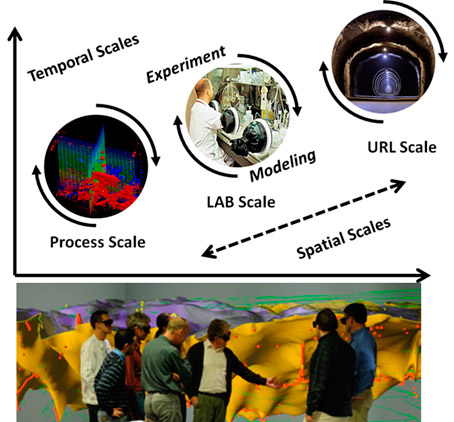iCross

Project title: Integrität von Endlagersystemen für radioaktive Abfälle – Skalenübergreifendes Systemverständnis und Systemanalyse
(Project title – English translation: Integrity of nuclear waste repository systems - Cross-scale system understanding and analysis)
Short project description:
The interdisciplinary project combines research competencies of Helmholtz scientists related to the topics nuclear, geosciences, biosciences and environmental simulations in a research field overarching collaboration. Essential experimental data and parameters will be derived and advanced modelling tools will be developed for the comprehensive simulation of potential repository evolutions covering the nano-scale up to the regional scale. Validation of parameters will be performed in specific experiments partly in large-scale underground research laboratories (URL). A focus will be set on the the Mt. Terri URL (CH; Opalinus clay), where under strong involvement of German partners a new experimental tunnel is excavated. Further activities will take place in the Grimsel Test Site (CH; crystalline rock). Research concentrates to specifically those host rock formations, where less research has been performed in Germany so far, i.e., to clay and crystalline.The project divides into different work packages addressing the topics: laboratory scale experiments, experiments in underground research laboratories, modelling and simulation for process and system analysis. In addition, it is foreseen to develop and apply advanced visualisation tools to clearly illustrate complex repository processes and to communicate them to the interested public. The project requires regular alignment, coordination and updating of work package. A further focus lies on the integration of young scientists and their networking. The project will be complemented by a second sub-project supported by the Helmholtz Association. The BMBF part will focus on geoscientific issues relevant in the far field of a repository. The Helmholtz part concentrates as well on near field processes. Both sub projects will be strongly interlinked.
Within the framework of the project activities, numerical methods for the analysis of thermal-hydraulic-mechanical/geochemical processes in rocks will be developed considering the existence of structural discontinuities. These methods will be implemented into the scientific open-source software OpenGeoSys, which ensures a direct and efficient access by all developers within the context of a joint programming of according partners of the joint project. Specifically, clay and crystalline rock will be considered with their typical kind of discontinuities using tailored numerical algorithms. Laboratory experiments of project partners are used to demonstrate the basic suitability of the developed methods, whereas in situ experiments will form the basis for the definition and parametrisation of practice-oriented test examples and typical numerical benchmarks for model and software validation. This approach serves the development and validation of methods aimed at the envisioned cross-scale system understanding of the different interacting repository compartments.
Project duration: 07/18 – 06/21
Funding organisation: BMBF and Helmholtz Association of German Research Centers


Project partners:
- Forschungszentrum Jülich (FZJ) – coordinator
- Helmholtz Centre Potsdam – GFZ German Research Centre for Geosciences
- Helmholtz-Zentrum Dresden-Rossendorf (HZDR)
- Karlsruhe Institute of Technology (KIT)
- Helmholtz Centre for Environmental Research – UFZ
The research for this project is being conducted in close cooperation with the Chair of Soil Mechanics and Foundation Engineering at the TU Bergakademie Freiberg.
At the UFZ, research for this project is also being conducted at the Department Isotope Biogeochemistry.
At the Department of Environmental Informatics, research for this project is being conducted at the workgroup Computational Energy Systems.
Project website: not available
This research is also part of the OpenGeoSys initiative (www.opengeosys.org).
